SignaLink 2 - a signaling pathway resource with multi-layered regulatory networks
- PMID: 23331499
- PMCID: PMC3599410
- DOI: 10.1186/1752-0509-7-7
SignaLink 2 - a signaling pathway resource with multi-layered regulatory networks
Abstract
Background: Signaling networks in eukaryotes are made up of upstream and downstream subnetworks. The upstream subnetwork contains the intertwined network of signaling pathways, while the downstream regulatory part contains transcription factors and their binding sites on the DNA as well as microRNAs and their mRNA targets. Currently, most signaling and regulatory databases contain only a subsection of this network, making comprehensive analyses highly time-consuming and dependent on specific data handling expertise. The need for detailed mapping of signaling systems is also supported by the fact that several drug development failures were caused by undiscovered cross-talk or regulatory effects of drug targets. We previously created a uniformly curated signaling pathway resource, SignaLink, to facilitate the analysis of pathway cross-talks. Here, we present SignaLink 2, which significantly extends the coverage and applications of its predecessor.
Description: We developed a novel concept to integrate and utilize different subsections (i.e., layers) of the signaling network. The multi-layered (onion-like) database structure is made up of signaling pathways, their pathway regulators (e.g., scaffold and endocytotic proteins) and modifier enzymes (e.g., phosphatases, ubiquitin ligases), as well as transcriptional and post-transcriptional regulators of all of these components. The user-friendly website allows the interactive exploration of how each signaling protein is regulated. The customizable download page enables the analysis of any user-specified part of the signaling network. Compared to other signaling resources, distinctive features of SignaLink 2 are the following: 1) it involves experimental data not only from humans but from two invertebrate model organisms, C. elegans and D. melanogaster; 2) combines manual curation with large-scale datasets; 3) provides confidence scores for each interaction; 4) operates a customizable download page with multiple file formats (e.g., BioPAX, Cytoscape, SBML). Non-profit users can access SignaLink 2 free of charge at http://SignaLink.org.
Conclusions: With SignaLink 2 as a single resource, users can effectively analyze signaling pathways, scaffold proteins, modifier enzymes, transcription factors and miRNAs that are important in the regulation of signaling processes. This integrated resource allows the systems-level examination of how cross-talks and signaling flow are regulated, as well as provide data for cross-species comparisons and drug discovery analyses.
Figures






References
Publication types
MeSH terms
LinkOut - more resources
Full Text Sources
Other Literature Sources
Molecular Biology Databases

